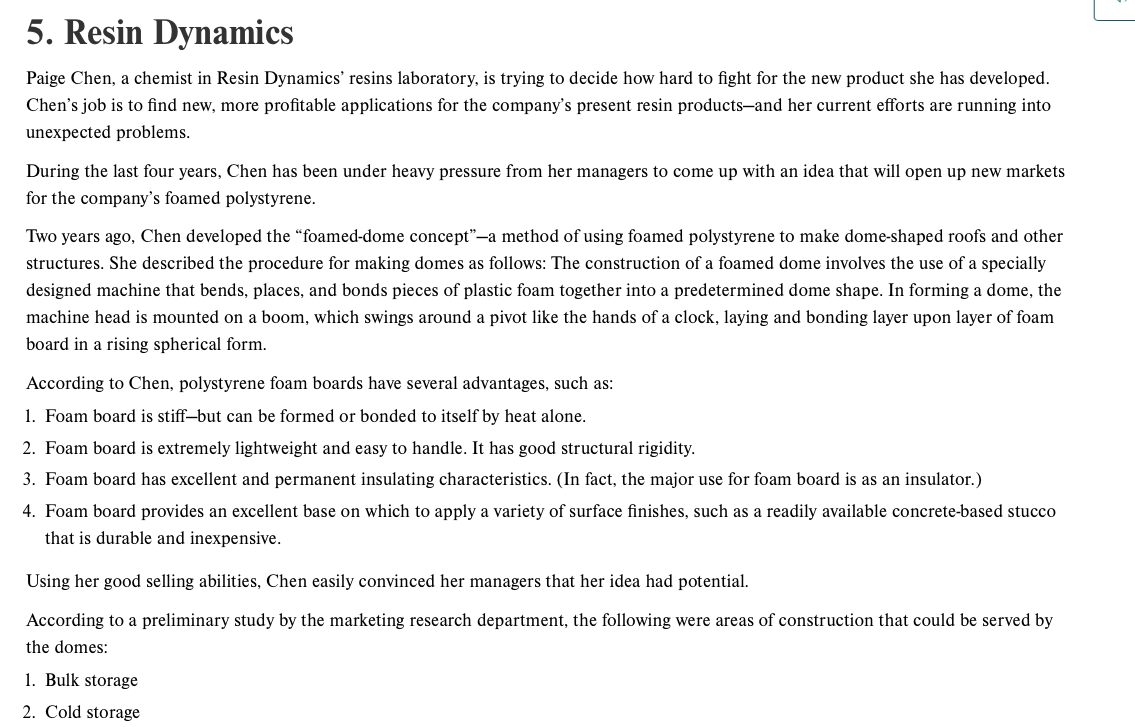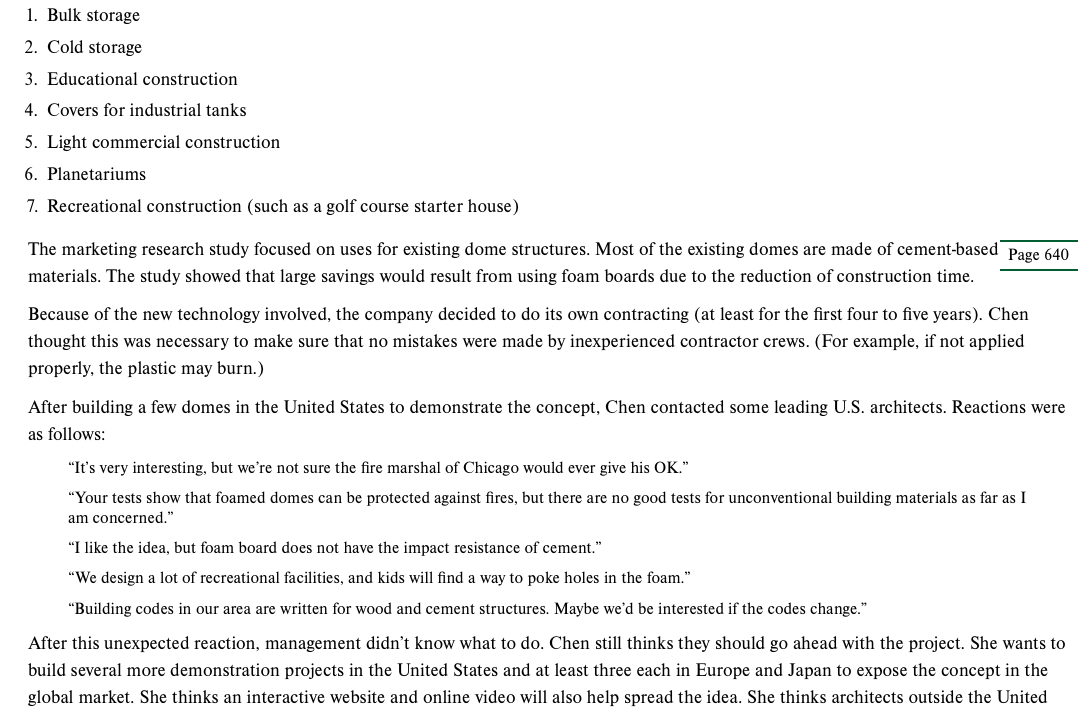Answered step by step
Verified Expert Solution
Question
1 Approved Answer
1. What orientation does Resin Dynamics appear to be using? Explain. 2. What factors and external environment did Resin Dynamics fail to consider before trying



1. What "orientation" does Resin Dynamics appear to be using? Explain.
2. What factors and external environment did Resin Dynamics fail to consider before trying to market the new product? 3. As a marketing consultant, what steps would you advise Resin Dynamics to now undertake?
4. Do you think this foamed-dome product can be successful? Should Resin Dynamics continue to invest in this product? Explain your reasoning.
Paige Chen, a chemist in Resin Dynamics' resins laboratory, is trying to decide how hard to fight for the new product she has developed. Chen's job is to find new, more profitable applications for the company's present resin products-and her current efforts are running into unexpected problems. During the last four years, Chen has been under heavy pressure from her managers to come up with an idea that will open up new markets for the company's foamed polystyrene. Two years ago, Chen developed the "foamed-dome concept"-a method of using foamed polystyrene to make dome-shaped roofs and other structures. She described the procedure for making domes as follows: The construction of a foamed dome involves the use of a specially designed machine that bends, places, and bonds pieces of plastic foam together into a predetermined dome shape. In forming a dome, the machine head is mounted on a boom, which swings around a pivot like the hands of a clock, laying and bonding layer upon layer of foam board in a rising spherical form. According to Chen, polystyrene foam boards have several advantages, such as: 1. Foam board is stiff-but can be formed or bonded to itself by heat alone. 2. Foam board is extremely lightweight and easy to handle. It has good structural rigidity. 3. Foam board has excellent and permanent insulating characteristics. (In fact, the major use for foam board is as an insulator.) 4. Foam board provides an excellent base on which to apply a variety of surface finishes, such as a readily available concrete-based stucco that is durable and inexpensive. Using her good selling abilities, Chen easily convinced her managers that her idea had potential. According to a preliminary study by the marketing research department, the following were areas of construction that could be served by the domes: 1. Bulk storage 2. Cold storage 3. Educational construction 4. Covers for industrial tanks 5. Light commercial construction 6. Planetariums 7. Recreational construction (such as a golf course starter house) The marketing research study focused on uses for existing dome structures. Most of the existing domes are made of cement-based materials. The study showed that large savings would result from using foam boards due to the reduction of construction time. Because of the new technology involved, the company decided to do its own contracting (at least for the first four to five years). Chen thought this was necessary to make sure that no mistakes were made by inexperienced contractor crews. (For example, if not applied properly, the plastic may burn.) After building a few domes in the United States to demonstrate the concept, Chen contacted some leading U.S. architects. Reactions were as follows: "It's very interesting, but we're not sure the fire marshal of Chicago would ever give his OK." "Your tests show that foamed domes can be protected against fires, but there are no good tests for unconventional building materials as far as I am concerned." "I like the idea, but foam board does not have the impact resistance of cement." "We design a lot of recreational facilities, and kids will find a way to poke holes in the foam." "Building codes in our area are written for wood and cement structures. Maybe we'd be interested if the codes change." After this unexpected reaction, management didn't know what to do. Chen still thinks they should go ahead with the project. She wants to build several more demonstration projects in the United States and at least three each in Europe and Japan to expose the concept in the global market. She thinks an interactive website and online video will also help spread the idea. She thinks architects outside the United After this unexpected reaction, management didn't know what to do. Chen still thinks they should go ahead with the project. She wants to build several more demonstration projects in the United States and at least three each in Europe and Japan to expose the concept in the global market. She thinks an interactive website and online video will also help spread the idea. She thinks architects outside the United States may be more receptive to really new ideas. Further, she says, it takes time for potential users to "see" and accept new ideas. She is sure that more exposure to more people will speed acceptance. And she is convinced that a few reports of well-constructed domes in leading trade papers and magazines will go a long way toward selling the idea. She is working on getting such reports right now. But her managers aren't sure they want to OK spending more money on "her" project. Her immediate boss is supportive, but the rest of the review board is less sure about more demonstration projects or going ahead at all-either in the United States or in global markets. Evaluate how Resin Dynamics got into the present situation. What should Paige Chen do? What should Chen's managers do? ExplainStep by Step Solution
There are 3 Steps involved in it
Step: 1

Get Instant Access to Expert-Tailored Solutions
See step-by-step solutions with expert insights and AI powered tools for academic success
Step: 2

Step: 3

Ace Your Homework with AI
Get the answers you need in no time with our AI-driven, step-by-step assistance
Get Started


